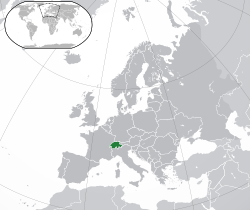Wp/iba/Switzerland
Appearance
Konfederasyen Swiss Lima nama resmi: | |
|---|---|
| Rambai jaku: (unofficial) "Unus pro omnibus, omnes pro uno" "One for all, all for one" | |
| Anthem: "Swiss Psalm" | |
 Location of Wp/iba/Switzerland (green) in Europe (green and dark grey) | |
| Indu menua |
46°57′N 7°27′E / 46.950°N 7.450°E |
| Nengeri ti pemadu besai | Zurich |
| Jaku resmi | |
| Pengarap (2022)[3] |
|
| Demonim |
|
| Perintah | Federal assembly-independent[4][5] directorial republic |
| Viktor Rossi | |
| Dewan Undangan Negeri | Federal Assembly |
| Council of States | |
| National Council | |
| History | |
• Founded | 1 August 1291[lower-alpha 2] |
• Sovereignty recognised (Peace of Westphalia) | 24 October 1648 |
| 7 August 1815 | |
| 12 September 1848[lower-alpha 3][6] | |
| Menua | |
• Pemesai | 41,285 km2 (15,940 bt2) (132nd) |
• Ai (%) | 4.34[7] |
| Penyampau tubuh | |
• 2023 estimate | 8,902,308[8] (99th) |
• 2015 census | |
• Pemayuh tubuh | 207/km2 (536.1/sq mi) (48th) |
| GDP (PPP) | 2024 estimate |
• Total | |
• Per capita | |
| GDP (nominal) | 2024 estimate |
• Total | |
• Per capita | |
| Gini (2022) | medium |
| HDI (2022) | very high · 1st |
| Mata duit | Swiss franc (CHF) |
| Zon jam | UTC+1 (CET) |
• Summer (DST) | UTC+2 (CEST) |
| Date format | dd.mm.yyyy (Anno Domini) |
| Tisi deriba | right |
| Kod talipaun | +41 |
| Kod ISO 3166 | CH |
| TLD Internet | .ch, .swiss |
Switzerland, enggau nama rasmi iya Konfederasyen Switzerland, iya nya sebengkah menua ti nadai pantai ti bepalan ba barat-tengah Eropah.
Malin
- ↑ Bern is referred to as "federal city" (Template:Wp/iba/Lang-de; Template:Wp/iba/Lang-fr; Template:Wp/iba/Lang-it; Template:Wp/iba/Lang-rm). Swiss law does not designate a capital as such, but the federal parliament and government are installed in Bern, while other federal institutions, such as the federal courts, are in other cities (Bellinzona, Lausanne, Lucerne, Neuchâtel, St. Gallen a.o.).
- ↑ Traditional date. The original date of the Rütli Oath was 1307 (reported by Aegidius Tschudi in the 16th century) and is just one among several comparable treaties between more or less the same parties during that period. The date of the Federal Charter of 1291 was selected in 1891 for the official celebration of the "Confederacy's 600th anniversary".
- ↑ A solemn declaration of the Tagsatzung declared the Federal Constitution adopted on 12 September 1848. A resolution of the Tagsatzung of 14 September 1848 specified that the powers of the institutions provided for by the 1815 Federal Treaty would expire at the time of the constitution of the Federal Council, which took place on 16 November 1848.
- ↑ Cite error: Invalid
<ref>tag; no text was provided for refs namedBundesstadt - ↑ Holenstein, André (2012). "Die Hauptstadt existiert nicht". UniPress – Forschung und Wissenschaft an der Universität Bern (scientific article) (id jaku German). Bern: Department Communication, University of Bern. 152 (Sonderfall Hauptstatdtregion): 16–19. doi:10.7892/boris.41280. S2CID 178237847.
Als 1848 ein politisch-administratives Zentrum für den neuen Bundesstaat zu bestimmen war, verzichteten die Verfassungsväter darauf, eine Hauptstadt der Schweiz zu bezeichnen und formulierten stattdessen in Artikel 108: "Alles, was sich auf den Sitz der Bundesbehörden bezieht, ist Gegenstand der Bundesgesetzgebung." Die Bundesstadt ist also nicht mehr und nicht weniger als der Sitz der Bundesbehörden.
[In 1848, when a political and administrative centre was being determined for the new federation, the founders of the constitution abstained from designating a capital city for Switzerland and instead formulated in Article 108: "Everything, which relates to seat of the authorities, is the subject of the federal legislation." The federal city is therefore no more and no less than the seat of the federal authorities.] - ↑ "Religion" (official statistics: population age 15+, observation period 2022). Swiss Federal Statistical Office. Diarkib ari asal ba 24 April 2020. Diambi 30 May 2020.
- ↑ Shugart, Matthew Søberg (December 2005). "Semi-Presidential Systems: Dual Executive And Mixed Authority Patterns". French Politics. 3 (3): 323–351. doi:10.1057/palgrave.fp.8200087. ISSN 1476-3419. S2CID 73642272.
- ↑ Elgie, Robert (2016). "Government Systems, Party Politics, and Institutional Engineering in the Round". Insight Turkey. 18 (4): 79–92. ISSN 1302-177X. JSTOR 26300453.
- ↑ Template:Wp/iba/HDS
- ↑ "Surface water and surface water change". Organisation for Economic Co-operation and Development (OECD). Diarkib ari asal ba 24 March 2021. Diambi 11 October 2020.
- ↑ "Bevölkerungsstand am Ende des 2. Quartals 2023 | Bundesamt für Statistik". 20 September 2023. Diarkib ari asal ba 20 September 2023. Diambi 20 September 2023.
- ↑ Jacqueline Kucera; Athena Krummenacher, eds. (22 November 2016). Switzerland's population 2015 (PDF) (Report). Swiss Statistics. Neuchâtel, Switzerland: Swiss Federal Statistical Office (FSO), Swiss Confederation. Diarkib ari asal ba 20 December 2016. Diambi 7 December 2016.
- ↑ 10.0 10.1 10.2 10.3 "World Economic Outlook Database, April 2024 Edition. (Switzerland)". www.imf.org. International Monetary Fund. 16 April 2024. Diarkib ari asal ba 28 June 2024. Diambi 16 April 2024.
- ↑ "Gini coefficient of equivalised disposable income – EU-SILC survey". ec.europa.eu. Eurostat. Diarkib ari asal ba 9 October 2020. Diambi 31 March 2024.
- ↑ "Human Development Report 2023/2024" (PDF). United Nations Development Programme. 13 March 2024. Diarkib (PDF) ari asal ba 13 March 2024. Diambi 13 March 2024.


